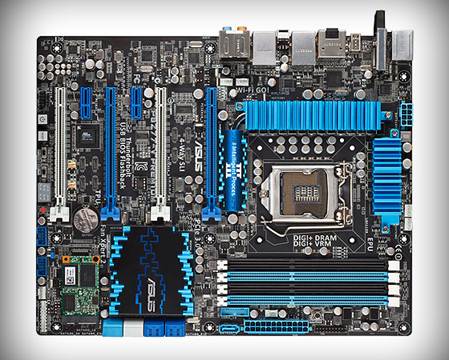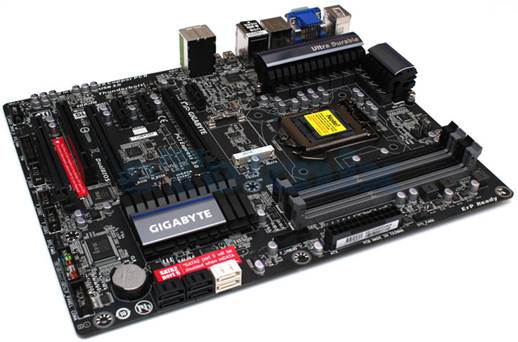Getting the new tech requires a new
motherboard
With our skepticism of Thunderbolt
officially blown away (see last month’s Head to Head) we’re now ready to
embrace the new I/O interface. But unless you’re one of the lucky few to have
an older Asus board with support for the company’s Thunderbolt add-in card,
you’ll need to buy a new motherboard to enjoy Tbolt goodness. Luckily,
Thunderbolt boards have arrived. To gauge the choices, we gathered up both the
priciest and cheapest Tbolt boards we could find and set at them.
ASUS P8Z77-V Premium
Verdict
Ratings: 8
Price: $450
Website: www.asus.com

The
Asus P8Z77-V Premium comes fully loaded with features, including Wi-Fi
antennas.
LGA2011 boards have always occupied the
luxury side of town, whereas LGA1155 has been pretty blue collar. Not anymore.
Asus’s new P8Z77-V Premium pretty much shatters the idea that LGA1155 boards
are low rent.
How swanky is it? This Z77 board is
brimming with every bell, whistle, and horn available. Obviously, Thunderbolt
is here, in the form of a single Thunderbolt port using Intel’s “Cactus Ridge”
DSL3310 second-gen Tbolt controller. Asus also equips the board with a PLX8747
PCIe 3.0 switch chip, so the board is able to run up to four GPUs. Boards
without a bridge chip are normally constrained to two GPUs, and some boards
switch off components too.
Want more? There’s also the excellent Asus
fan controls, a Wi-Fi and Bluetooth module, a secondary Marvell SATA 6Gb/s
with four ports, and a 32GB Lite-On SSD in the mSATA slot, in addition to the
two Gigabit ports running Intel silicon. There’s so much hardware jammed onto
this board, it takes an afternoon just to go through the UEFI settings.
Performance of the board is quite good,
especially with the "free" mSATA SSD used for caching (which we did
for our testing).

So how much does all this hardware cost? A
lot. At $450, the P8Z77-V Premium is the most expensive Z77 board we’ve reviewed.
And unfortunately, not all the features make sense to us. The mSATA, for
example, isn’t useful for anything beyond caching due to its size. But will
someone who runs a 4x GPU setup and Thunderbolt really be running a hard disk
as his or her primary boot device?
For the most part, you have to have
particular needs to want the P8Z77-V Premium. Obviously, just wanting the most
tricked-out Z77 board on the market is one need. The other is more practical:
You need to run more than three GPUs and you must have Thunderbolt. Frankly,
without those specific needs, we think it would be more fiscally prudent to buy
a non-Premium version of the P8Z77-V and add the optional Thunderbolt card.
Don’t get us wrong, the P8Z77-V Premium is
fully loaded, stable, and the fastest-booting Z77 board we’ve tested yet (it’ll
go from cold to OS in 17 seconds in Windows 8) but most folks will likely find
it just too much motherboard for too much money.
Gigabyte Z77X-UP4 TH
Verdict
Ratings: 8
Price: $190
Website: www.qiqabvte.vn

It’s
hard to believe you can get a board with not one, but two Thunderbolt ports for
under $200.
It’s commonly understood that if you can
run Thunderbolt, you probably also snack on Beluga caviar, wear a Patek
Philippe watch, and vacation in a country only rich people know about:
Grenyarnia.
Not so, actually. Thunderbolt apparently
doesn’t require you to smash the piggy. This is no more apparent than with
Gigabyte’s Z77X-UP4 TH. What the TH stands for we don’t know for sure, but
we’re guessing it has some relation to Thunderbolt, which the Z77X-UP4 TH has
in spades.
The Z77X-UP4 TH pretty much has all the
modern must-have components, including both native Intel and discrete VIA USB
3.0 ports. There’s also SLI/CrossFireX, an mSATA slot, and not one, but two
Thunderbolt ports

The fact that Gigabyte can jam all this
into a board that streets for $190 is astounding. Lest you think the board is
the equal of the P8Z77-V Premium, it isn’t. The lack of extra SATA controllers,
surface-mount power switches, extra SATA ports, and a POST LED affirms this
board’s pedestrian pedigree, but for the price difference, you could buy a CPU.
In performance, the board gave us interesting
results. It’s the first one we’ve tested that has faster USB 3.0 performance
than the Asus boards, but in overall graphics and system performance, the
Gigabyte was slightly slower than the Premium board. To be fair, we did enable
SSD caching on the Asus P8Z77-V Premium, but that’s because the board comes
with it. Like other Gigabyte boards, the Z77X-UP4 TH turned out
slower-than-expected performance in some graphics tests. It’s not a huge disparity.
but it shows up in the numbers. Because we’ve seen it in three Gigabyte boards
now, it’s likely some driver-related issue.
Another thing we should note is that our
review board smelled like an iPhone crawled into the ass of a laptop and died
there. The heavy electronic stink was so overwhelming, we were ready to bury
our face in a skunk to get rid of the odor. The smell diminished overtime, but
P.U.!
Despite the smell, it’s hard to argue with
the bargain you’re getting here. The board lets you run multicard setups, packs
two Thunderbolt ports (which were tested to within a few percentage points of
the Asus P8Z77-V Premium), and even seems to have improved the USB 3.0 performance
markedly. Yes, it could use a couple more SATA ports and a good airing out, but
for the money, we ain’t arguing.
Benchmarks
|
|
Asus P8Z77-V Premium
|
Gigabyte GA-Z77X-UP4 TH
|
Asus P8Z77-V
|
|
Price
|
$450
|
$190
|
$190
|
|
3DMark 11 Overall
|
P6,253
|
P5,914
|
P6,308
|
|
PCMark 7 Overall
|
5,395
|
3,709
|
3,739
|
|
PCMark 7 Lightweight
|
5,194
|
2,665
|
2,755
|
|
PCMark 7 Productivity
|
5,442
|
2,506
|
2,610
|
|
Valve Particle (fps)
|
210
|
203
|
208
|
|
SiSoft Sandra 2012 (GB/s)
|
21.2
|
21
|
21.3
|
|
SATA 6Gb/s read (MB/s)
|
517.2
|
494.4
|
509.9
|
|
SATA 6Gb/s write (MB/s)
|
255.3
|
225.9
|
247.1
|
|
USB 3.0 Read (MB/s)
|
429.4
|
486.8
|
429.9
|
|
USB 3.0 Write (MB/s)
|
183.9
|
223.6
|
181.3
|
|
SLI Compliance
|
Yes (4-way)
|
Yes
|
Yes
|
|
32GB Compliance
|
Yes
|
Yes
|
Yes
|
|
Auto Overclock (GHz)
|
4.3
|
4.43
|
4.2
|
Best scores are bolded. We used a Core
i7-3770K, 8GB of DDR3/1866 set at DDR3/1600, a WD Raptor 150, 64-bit Windows 7
Profession, and a GeForce GTX 580 in all of our motherboards, SATA 6Gb/s speeds
were measured with CrystalDiskMark 3.01 and an OWC Mercury Extreme SSD. USB 3.0
speeds were measured with CrystalDiskMark and a Patriot Wildfire SSD in a USB
3.0 enclosure using an Asmedia controller, 32GB compliance was measured with
four 8GB DDR3 modules. The P8Z77-V Premium board was tested in SSD-caching mode.